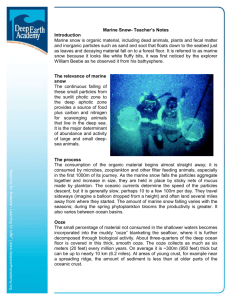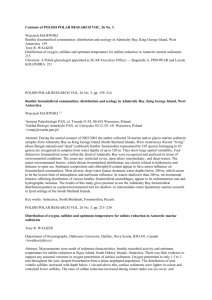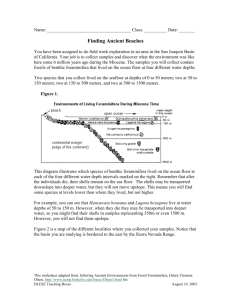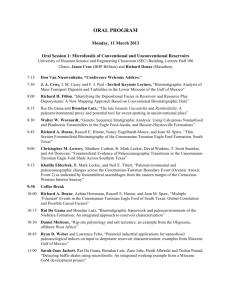Propagule transport as a key method of dispersal in benthic... Elisabeth Alve Susan T. Goldstein
advertisement
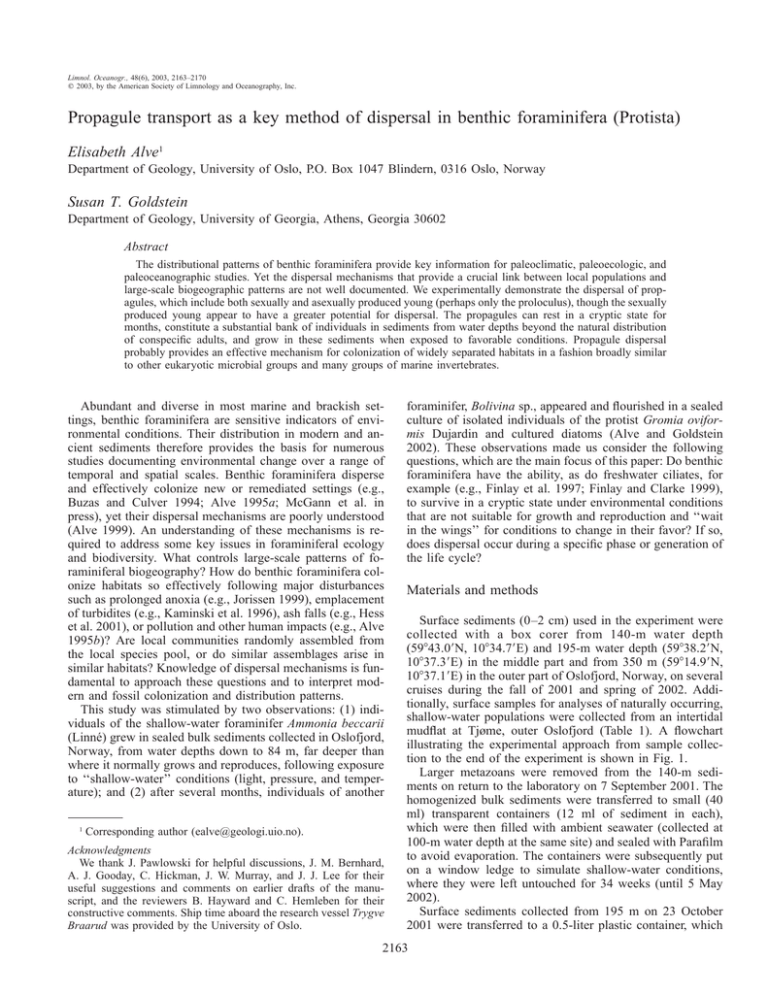
Limnol. Oceanogr., 48(6), 2003, 2163–2170 q 2003, by the American Society of Limnology and Oceanography, Inc. Propagule transport as a key method of dispersal in benthic foraminifera (Protista) Elisabeth Alve1 Department of Geology, University of Oslo, P.O. Box 1047 Blindern, 0316 Oslo, Norway Susan T. Goldstein Department of Geology, University of Georgia, Athens, Georgia 30602 Abstract The distributional patterns of benthic foraminifera provide key information for paleoclimatic, paleoecologic, and paleoceanographic studies. Yet the dispersal mechanisms that provide a crucial link between local populations and large-scale biogeographic patterns are not well documented. We experimentally demonstrate the dispersal of propagules, which include both sexually and asexually produced young (perhaps only the proloculus), though the sexually produced young appear to have a greater potential for dispersal. The propagules can rest in a cryptic state for months, constitute a substantial bank of individuals in sediments from water depths beyond the natural distribution of conspecific adults, and grow in these sediments when exposed to favorable conditions. Propagule dispersal probably provides an effective mechanism for colonization of widely separated habitats in a fashion broadly similar to other eukaryotic microbial groups and many groups of marine invertebrates. Abundant and diverse in most marine and brackish settings, benthic foraminifera are sensitive indicators of environmental conditions. Their distribution in modern and ancient sediments therefore provides the basis for numerous studies documenting environmental change over a range of temporal and spatial scales. Benthic foraminifera disperse and effectively colonize new or remediated settings (e.g., Buzas and Culver 1994; Alve 1995a; McGann et al. in press), yet their dispersal mechanisms are poorly understood (Alve 1999). An understanding of these mechanisms is required to address some key issues in foraminiferal ecology and biodiversity. What controls large-scale patterns of foraminiferal biogeography? How do benthic foraminifera colonize habitats so effectively following major disturbances such as prolonged anoxia (e.g., Jorissen 1999), emplacement of turbidites (e.g., Kaminski et al. 1996), ash falls (e.g., Hess et al. 2001), or pollution and other human impacts (e.g., Alve 1995b)? Are local communities randomly assembled from the local species pool, or do similar assemblages arise in similar habitats? Knowledge of dispersal mechanisms is fundamental to approach these questions and to interpret modern and fossil colonization and distribution patterns. This study was stimulated by two observations: (1) individuals of the shallow-water foraminifer Ammonia beccarii (Linné) grew in sealed bulk sediments collected in Oslofjord, Norway, from water depths down to 84 m, far deeper than where it normally grows and reproduces, following exposure to ‘‘shallow-water’’ conditions (light, pressure, and temperature); and (2) after several months, individuals of another 1 Corresponding author (ealve@geologi.uio.no). Acknowledgments We thank J. Pawlowski for helpful discussions, J. M. Bernhard, A. J. Gooday, C. Hickman, J. W. Murray, and J. J. Lee for their useful suggestions and comments on earlier drafts of the manuscript, and the reviewers B. Hayward and C. Hemleben for their constructive comments. Ship time aboard the research vessel Trygve Braarud was provided by the University of Oslo. foraminifer, Bolivina sp., appeared and flourished in a sealed culture of isolated individuals of the protist Gromia oviformis Dujardin and cultured diatoms (Alve and Goldstein 2002). These observations made us consider the following questions, which are the main focus of this paper: Do benthic foraminifera have the ability, as do freshwater ciliates, for example (e.g., Finlay et al. 1997; Finlay and Clarke 1999), to survive in a cryptic state under environmental conditions that are not suitable for growth and reproduction and ‘‘wait in the wings’’ for conditions to change in their favor? If so, does dispersal occur during a specific phase or generation of the life cycle? Materials and methods Surface sediments (0–2 cm) used in the experiment were collected with a box corer from 140-m water depth (59843.09N, 10834.79E) and 195-m water depth (59838.29N, 10837.39E) in the middle part and from 350 m (59814.99N, 10837.19E) in the outer part of Oslofjord, Norway, on several cruises during the fall of 2001 and spring of 2002. Additionally, surface samples for analyses of naturally occurring, shallow-water populations were collected from an intertidal mudflat at Tjøme, outer Oslofjord (Table 1). A flowchart illustrating the experimental approach from sample collection to the end of the experiment is shown in Fig. 1. Larger metazoans were removed from the 140-m sediments on return to the laboratory on 7 September 2001. The homogenized bulk sediments were transferred to small (40 ml) transparent containers (12 ml of sediment in each), which were then filled with ambient seawater (collected at 100-m water depth at the same site) and sealed with Parafilm to avoid evaporation. The containers were subsequently put on a window ledge to simulate shallow-water conditions, where they were left untouched for 34 weeks (until 5 May 2002). Surface sediments collected from 195 m on 23 October 2001 were transferred to a 0.5-liter plastic container, which 2163 2164 Alve and Goldstein Table 1. Details of samples from which populations of Ammonia beccarii and Haynesina germanica grew.* Water depth (m)† Intertidal 140 195 195 350 350 Date of collection 3 7 23 30 30 30 Aug 02 Sep 01 Oct 01 Apr 02 Apr 02 Apr 02 Experiment Onset 7 15 5 5 5 — Sep 01 Feb 02 May 02 May 02 May 02 5 1 2 2 2 A. beccarii H. germanica End Sediment used Test Proloculus — May 02 May 02 Aug 02 Aug 02 Aug 02 Bulk‡ Bulk ,63 mm ,32 mm ,63 mm ,32 mm x x x x x x x x x x Test ‘‘Cysts’’ x x x x x * ‘‘x’’ denotes which aspects of the two species’ morphology (test, prolocular, or ‘‘cyst’’ maximum diameter) were measured. † Same water depth represents same site. ‡ In situ sediment with a naturally occurring A. beccarii population, not subjected to experimental conditions. was subsequently filled with ambient seawater and then sealed and stored in a darkened cold-room at ambient temperature (6–78C) for 16.5 weeks (until 15 February 2002), when the sediment was sieved (in ambient seawater collected at the same time as the sediments, i.e., both sediment and water had been stored for 16.5 weeks). The ,63-mm fraction was transferred to small containers, as described above, and placed on the window ledge for 10.5 weeks (until 1 May 2002). Sediments collected on 30 April 2002 from the 195- and 350-m sites were kept in the cold-room in ambient seawater until 5 May 2002, when the sediment was sieved on a 1,000mm sieve to remove larger organisms. The ,1,000-mm fraction was sieved through either a 32- or 63-mm sieve. The ,32-mm sediment was left to settle in the cold-room for 3 h, and the water was decanted. The settled ,32-mm sediment was homogenized, transferred to 40-ml containers (12 ml in each), and filled with the decanted water; then, the containers were sealed and put on the window ledge. All containers remained sealed throughout the experimental period. A portion of the ,63-mm sediment from the 350-m site was also sealed in 40-ml containers in the same manner as the ,32-mm sediment. Sediments finer than either 63 or 32 mm, rather than bulk sediments, were used in this experiment to determine whether growth commenced from juveniles or adults (adults measure up to 600 mm, whereas the smallest juveniles measure only ;15–50 mm, depending on their specific generation of the life cycle). To determine whether any adult shallow-wa- Fig. 1. General outline of experimental approach. ter foraminifera (alive or as empty shells) were present in the original collections, a portion of the .63-mm sediment from fresh collections of all three deeper-water sites was preserved in 70% ethanol with rose bengal (1 g L21) and then processed and examined for foraminiferal content. Experimental containers from the 30 April 2002 collection (195- and 350-m sites) were randomly selected, resieved, and examined after 3.5, 9, and 12.5 weeks (i.e., 30 May 2002, 7 July 2002, and 2 August 2002, respectively). The intertidal surface samples were sieved, and individuals of A. beccarii in the .125-mm fraction were removed for further examination. Maximum test diameter was measured on whole tests present in selected samples from the 30 April 2002 collections that were examined on 30 May 2002 and 7 July 2002. Both prolocular and maximum test diameter in adult specimens of A. beccarii were measured in (1) the naturally occurring, intertidal population, (2) a population that grew from unsieved (bulk) 140-m sediments, (3) a population that grew from 350-m sediments ,63 mm, and (4) two populations that grew in 350-m sediments ,32 mm. Results Individuals of the shallow-water species A. beccarii and Haynesina germanica (Ehrenberg) (Fig. 2) grew in the sediments collected at all three deep-water sites after having been exposed to simulated shallow-water conditions. One of the first sealed containers with ,32 mm of sediment examined from the 195-m site (after 3.5 weeks) revealed .100 small living individuals (most were 110–120 mm) of H. germanica (Fig. 3; Table 2). The sample also contained .50 nearly spherical, cystlike, agglutinated structures (;200 mm in diameter) consisting of fine-grained detrital material (Fig. 2B), some whole and some with openings that had a hollow interior cavity. Otherwise, the sample contained algal fragments only. Each whole ‘‘cyst’’ contained one young H. germanica, with dark green cytoplasm, just like those found outside these structures. Samples from the 350-m site that had been exposed to shallow-water conditions for 9 and 12.5 weeks either contained no foraminifera or had numerous individuals (74– 433) of one or both of these two shallow-water species, including large adult specimens (up to ;600 mm). Although many tests contained cytoplasm, all individuals appeared to Dispersal in benthic foraminifera 2165 (up to 240 mm) grew in the sediment fraction ,63 mm that had been kept in a sealed container in a darkened cold-room for nearly 4 months before the start of the experiment. No tests of either species were recorded in the .63-mm fraction after these 4 months. Discussion A. beccarii and H. germanica, the two species of concern in this study, are common, widespread, euryhaline, intertidal-to-estuarine or lagoonal species that are generally restricted to ,20-m water depth. A. beccarii, being less euryhaline than H. germanica, can live somewhat deeper subtidally (Murray 1991). However, in Oslofjord, where the sediments for the present study were collected, live A. beccarii are uncommon below 20 m, and only empty shells are, on rare occasions, recorded below 40 m (see discussion in Alve and Goldstein 2002). In this study, we refer to the Ammonia species present in these samples as A. beccarii, a designation consistent with previous studies in this region. Fig. 2. Micrographs of individuals grown in experimental containers exposed to simulated shallow-water conditions. (A, B) H. germanica. (A) General view. (B) Agglutinated cystlike structure containing H. germanica. (C, D) A. beccarii. (C) Megalospheric form with large proloculus (arrow). (D) Microspheric form with small proloculus (arrow). All scale bars 5 20 mm. be dead, probably due to exposure to unusually high temperatures (.408C in cultures) in June 2002. Two of the three samples containing H. germanica also had abundant agglutinated oval-to-spherical ‘‘cysts’’ (length, 360–540 mm; mean, 430 mm; width, 260–460 mm; mean, 350 mm). As in May, each whole cyst contained an individual of H. germanica, whereas many of the empty cysts had a fracture that looked like an ‘‘escape’’ hole. A bimodal size distribution was recorded in one of the H. germanica populations examined on 7 July (i.e., after 9 weeks, Fig. 3). No shallowwater species were recorded among the thousands of foraminiferal tests examined from the .63-mm fraction of fresh field collections from the three deep-water sites. Megalospheric tests (prolocular diameter, ;30–50 mm) (Fig. 2C) dominated both the naturally occurring intertidal A. beccarii population and the population that grew in unsieved sediment from 140-m water depth (Fig. 4A,B). Of the populations that grew in sediment collected from the 350-m site, microspheric tests (prolocular diameter, ;15–30 mm) (Fig. 2D) dominated both the ,32- and ,63-mm sediment samples (Fig. 4C,D). Efforts were made to isolate propagules from a portion of the ,32-mm sediment collected at the 195-m site by examining the 10- to 30-mm sediment fraction. Small spheres were present that were probably foraminiferal proloculi. However, many different species of calcareous foraminifera have proloculi that are morphologically quite similar, and distinguishing those that belong to shallow-water taxa from those of the in situ species was not feasible based solely on morphological criteria. Numerous A. beccarii (up to 300 mm) and H. germanica Growth and reproduction under simulated shallow-water conditions—During the course of this study, hundreds of individuals of the two shallow-water species A. beccarii and H. germanica grew in each of several 12-ml samples of deep subtidal and upper bathyal clay- and silt-sized sediments after having been exposed to simulated shallow-water conditions for at least 3 weeks (Tables 1, 2). All populations refer to individuals grown in sediments with a grain size ,32 mm unless otherwise stated. The numerous small H. germanica recorded in agglutinated cysts on 30 May 2002 were young individuals. That the individuals not contained in cysts were more or less covered in sediment (with the same characteristics as the cysts) indicates that they had been enclosed in cysts during the experimental period and that parts of the cyst had been broken or eroded during sieving just prior to examination. Although foraminifera construct protective coverings during a variety of processes (e.g., reproduction, shell growth, feeding), these are probably growth cysts, and the individuals had not yet reached a stage at which they were ready to emerge. We do not know if the presence of empty, open cysts was a processing artifact or if some individuals had emerged prior to processing. However, some of the empty cysts were intact except for a small ‘‘escape’’ fracture, indicating that certain individuals had left their cysts before the sample was processed. To the authors’ knowledge, growth cysts have not previously been reported in H. germanica. This may be because in ‘‘untreated’’ field samples (i.e., where naturally occurring sand-sized material has not been removed), whole ‘‘cysts’’ would be very difficult to notice because of their similarity to naturally occurring sediment aggregates. We also observed that the rose bengal vital stain is not apparent through the ‘‘cyst’’ walls. The bimodal size distribution of H. germanica in sample containers examined on 7 July (i.e., after 9 weeks, Fig. 3, lower left) indicates that reproduction had taken place sometime between late May and early July, probably in June, as the 30 May population had only individuals about 100 mm in diameter (Fig. 3). Consequently, some individuals started 2166 Alve and Goldstein Fig. 3. Size distribution (maximum diameter) of individuals of H. germanica (left) and A. beccarii (right) grown in subsamples of ,32 mm of sediment within 3.5 and 9 weeks after exposure to simulated shallow-water conditions. The sediments were collected at 195- and 350-m water depths. Table 2. Ammonia beccarii and Haynesina germanica. The number of individuals and agglutinated cystlike structures that contained H. germanica (all .32 mm) that grew in experimental sediment containers for 3.5–12.5 weeks. Sediment (,32 mm) was collected from two sites (195 and 350 m) in Oslofjord, Norway, both deeper than the natural occurrence of adults of these two species of shallow-water foraminifera. Note that all individuals probably died in June 2002 (i.e., before the ninth week). No. weeks 195-m sediment A. beccarii 3.5 9 0 92 9 9 9 9 12.5 12.5 12.5 12.5 12.5 0 160 152 0 0 0 433 146 74 H. germanica .100 0 350-m sediment 149 242 0 335 175 259 0 0 0 ‘‘Cysts’’ .50 0 145 33 0 0 .10 0 0 0 0 reproducing under the simulated shallow-water conditions about 1 month after they were exposed to the experimental conditions. By 7 July, all recorded individuals were dead (probably due to exposure to high temperatures). By assuming they all died more or less at the same time, the shape of the size distribution curve for H. germanica in the other 7 July sample indicates that growth and reproduction did not happen at the same time in all containers even though they were exposed to the same external environmental conditions. Unlike H. germanica, most A. beccarii from 7 July are medium- to large-sized adults (.250 mm), indicating that this species either started growing earlier than H. germanica or that it grew more quickly. Either way, our data do not indicate that it reproduced before the populations died. Dispersal—As no shallow-water species were recorded among the thousands of foraminiferal tests examined from the .63-mm fraction of fresh, deeper-water field collections, both species must have been present as juveniles ,63 mm that were transported from shallow-water habitats. Because benthic foraminifera do not have swimming abilities and a meroplanktonic life stage is known for only five genera (but not for those examined in this study), their dispersal depends on passive transport (Alve 1999). Although transport of adult specimens by water currents has been reported (e.g., Loose Dispersal in benthic foraminifera Fig. 4. Size distribution of prolocular diameter in A. beccarii. (A) Individuals from a naturally occurring intertidal population. (B) Population that grew in bulk (unsieved) sediments collected at 140-m water depth. (C) Population that grew in ,63-mm sediments collected at 350-m water depth. (D) Population that grew in ,32mm sediments collected at 350-m water depth. 1970; Hueni et al. 1978; Kitazato 1995), their ability to become suspended and transported seems to be lower than for other major marine meiofaunal groups (Sherman and Coull 1980). This may be due to extensive sticky pseudopodal networks ‘‘anchoring’’ advanced growth stages to the surrounding sediment. Consequently, because of the broad geographic distribution of many benthic species (Murray 1991), it is reasonable to assume that they also have other, more efficient means of dispersal. Dispersal of juvenile growth stages is 2167 common in many organisms but has not been previously documented for foraminifera. In the majority of benthic foraminiferal species for which aspects of reproduction have been studied, gametogenesis produces numerous biflagellated, free-swimming gametes that are released directly into the surrounding seawater (Goldstein 1997). Foraminiferal gametes are isogamous, though the process is otherwise comparable to free-spawning in many groups of marine invertebrates. Ultrastructurally, foraminiferal gametes have very small food reserves (i.e., few lipid droplets, Goldstein unpubl. data) and no mechanism for acquiring food. Still, they are very active (Goldstein and Barker 1990) and would probably deplete food reserves quickly. The maximum distance over which foraminiferal gametes can travel and still achieve fertilization has not been documented. However, culture studies show that foraminiferal gametes do not survive in the laboratory for more than about ½ d (see p. 655 in Jepps 1942; Goldstein unpubl. data). Consequently, and in agreement with sperm limitation in free-spawners (Yund 2000), the likelihood that they would travel as far as several kilometers and encounter another gamete of the same species for fertilization is very low. Gametes therefore are probably not the stage of the foraminiferal life cycle that undergoes significant dispersal. The typical foraminiferal life cycle includes an alternation of sexually produced (diploid) and asexually produced (haploid) generations (for review, see Goldstein 1999 and references therein). Asexual reproduction is accomplished by multiple fission and includes meiosis (Le Calvez 1950). In many species, the different generations can be distinguished by shell dimorphism: the sexually produced generation is microspheric in that its shell has a distinctly smaller proloculus (first-formed chamber); the asexually produced generation has a larger proloculus and is thus megalospheric. Repeated asexual generations may intervene prior to sexual reproduction in some species, a process that may explain the preponderance of megalospheric shells in most natural populations (Leutenegger 1977). Shells of A. beccarii are classically dimorphic (Fig. 2C,D), and the life cycle of this and closely related species includes intervening asexual generations (e.g., Bradshaw 1957; Schnitker 1974; Goldstein and Moodley 1993; Stouff et al. 1999). The life cycle of H. germanica, however, has not been documented, and because its planispiral, involute morphology shields its proloculus from direct observation (Fig. 2A), results on the life cycle in this study focus on A. beccarii. Megalospheric tests (prolocular diameter, ;30–50 mm) dominated both the naturally occurring intertidal A. beccarii population and that which grew from unsieved sediment from 140-m water depth (Fig. 4A,B). Of the populations that grew in sediment collected from the 350-m site, microspheric tests (prolocular diameter, ;15–30 mm) dominated not only the ,32-mm sediment samples but also the ,63mm sediment samples (Fig. 4C,D). The latter shows that the dominance of microspheric forms reflects the original distribution of generations in the original sediments (i.e., it was not an artifact of the sediment size fraction used in the experiment). Overall, our results show that the dispersing propagules are quite small and may consist of only the proloculus. Propagule dispersal therefore appears to occur shortly 2168 Alve and Goldstein after reproduction and is analogous to larval dispersal in many marine invertebrates. Growth of both microspheric and megalospheric individuals in these sample populations indicates that both sexually produced and asexually produced generations undergo dispersal. In many natural populations, megalospheric individuals far outnumber microspheric individuals (Myers 1942, 1943a,b; Boltovskoy and Wright 1976; Leutenegger 1977; Nigam 1986), and this is also the case for the intertidal, natural population of A. beccarii of this study. Consequently, the overwhelming abundance of microspheric individuals in populations that grew in sediments from the deeper-water station (350 m) is unusual. Microspheric proloculi are about half the size of their megalospheric counterparts, and it is possible that they therefore undergo broader dispersal. Alternatively, the abundance of microspheric individuals may reflect seasonality: sediments from the 350-m site were collected in late April, perhaps following sexual reproduction and subsequent dispersal of propagules from shallow-water habitats during the previous summer or fall. Hofker (1930) reported the presence of only microspheric individuals of Ammonia (5Rotalia) beccarii flevensis in the Zuidersee (a Dutch inland ‘‘sea’’ that has since been drained) during the coldest part of the winter season and the hottest portion of the summer. Boltovskoy and Wright (1976) and Hallock (1985) have suggested that microspheric individuals prevail when environmental conditions are unfavorable or highly variable. As sexual reproduction (which produces microspheric individuals) results in higher genetic variability in populations (Hallock 1985), the presence of abundant microspheric individuals suggests that propagules would deliver populations with higher genetic diversity than if dispersal occurred predominantly in megalospheric forms. This seems, for example, to be the case for the parasitic Hyrrokkin sarcophaga, which is an attached/clinging form. Whereas the megalospheric generation in H. sarcophaga clings to the host by its pseudopods until it has undergone gamontogamy, the microspheric generation, which is much less common on hosts, probably is the one undergoing random planktonic dispersal (Cedhagen 1994). Collectively, these data indicate that the microspheric generation, which contains the higher genetic variability, is the most readily dispersed in the freely motile, soft-bottom foraminiferal species reported in this study as well as in the attached/clinging species. Dispersal through propagule transport is probably essential for largesized and attached foraminifera that are not easily entrained at a later life stage. This is supported by the fact that the latter group includes some of the most successful and abundant colonizing organisms on hard substrates in the deep sea (see discussion in Alve 1999). Dormancy—Numerous A. beccarii and H. germanica grew in the sediment fraction finer than 63 mm that had been kept in a sealed container in a darkened cold-room for nearly 4 months before the start of the experiment. That no tests of either species were recorded in the .63-mm fraction after these 4 months implies that small individuals (,63 mm) of both species had been present and were capable of surviving ;4 months before the environmental conditions became favorable for growth. Different physiological mechanisms produce dormancy in invertebrates. Diapause is maintained by an internal physiological response, whereas quiescent processes such as hibernation and cryptobiosis (‘‘hidden life’’) are induced and maintained by adverse environmental conditions (Cáceres 1997). Although dormancy has not yet been documented in benthic foraminifera, there are several lines of evidence suggesting that adult specimens can undergo dormancy (e.g., Erskian and Lipps 1987; Bernhard and Alve 1996). Our data show that juvenile foraminifera, like those of many other groups of organisms, can survive for months under suboptimal environmental conditions and subsequently grow once suitable conditions occur. Results therefore suggest that some benthic foraminifera undergo cryptobiosis, perhaps in a fashion similar to other eukaryotic microbial groups (e.g., Finlay et al. 1997; Finlay and Clarke 1999). In the present context, cryptobiosis implies ‘‘hidden life’’ due to small size and represents a survival strategy. Dispersal potential—Although only 12 ml of sediment was placed in each sample container at the start of the experiment, the populations of A. beccarii and/or H. germanica that grew were relatively large, commonly with .100 individuals in each. Most of them must have been present in the original (preexperiment) sediments as small propagules, because reproduction (as indicated by a bimodal size distribution) was only recorded in H. germanica from one container. However, the foraminifera did not grow in all of the sample containers, and they either grew in relatively large numbers or did not grow at all. These differences between containers probably reflect microenvironmental variability. Small green or brown algal mats, for example, became established in some containers but not others, and visual inspection revealed differences in sediment coloration among containers. Although juvenile foraminifera often have a clumped distribution following multiple fission (asexual reproduction) in the parent, this probably does not explain variation in foraminiferal growth in sample containers because, first, the sediment was agitated and sieved prior to filling the sample containers, and second, most foraminifera that grew in sediments from the 350-m site were microspheric individuals, the products of sexual reproduction. The high concentrations of propagules in all containers where growth commenced suggest the presence of a sizeable bank of propagules in sediments beyond the normal distribution of their adult counterparts. The density of small foraminiferal propagules is not documented, though evidence suggests that they have a density close to that of seawater. Juveniles of Ammonia that consist of only the proloculus initially are not calcified (Stouff et al. 1999), and small juveniles of calcareous foraminifera in general may be only weakly calcified (Hemleben pers. comm.). Coupled with the ability to become dormant, such a sizeable bank of lowdensity propagules provides some species of benthic foraminifera with substantial potential for both dispersal and colonization. In spite of this potential, shallow-water benthic foraminifera generally are not cosmopolitan, and morphologically similar populations that occupy comparable environments in separate regions may be genetically distinct (e.g., Holzmann 2000). The general lack of cosmopolitan Dispersal in benthic foraminifera shallow-water benthic foraminiferal species appears to contradict our propagule theory for dispersal because efficient dispersal would intuitively imply a continuous gene flow between areas, thus maintaining genetic consistency. However, despite a high dispersal potential, there are several factors that may prevent the same genetic species from successfully colonizing widely separate habitats. For example, although polychaete larvae may have the ability to travel across an ocean, panoceanic distributional patterns do not emerge. Rather, hydrodynamic processes may retain pelagic phases within a single geographic region, and environmental conditions may vary slightly but sufficiently to constrain the distribution of adults (Bhaud 1998). Furthermore, according to the Monopolization Hypothesis, regional genetic differentiation largely reflects the historical colonization of new habitats (resilient founder effects), meaning that, because of the low establishment success of new invaders, high dispersal capacity does not necessarily imply a high level of gene flow (de Meester et al. 2002). Consequently, if these processes also work for foraminifera, it may explain why morphologically very similar forms diverge genetically. Taking our present approach, the species pool concept of Buzas and Culver (1994) may be broadened to include all appropriate environments within geographic areas interconnected by water current systems. Ecological constraints on growth and maintenance of adults as well as the Monopolization Hypothesis may help explain why, as reported by Buzas and Culver, only some of the species that emigrate during regressions return during subsequent transgressions. The propagule dispersal theory also provides a potential explanation for the disjunct distribution of many shallow-water benthic foraminifera. It may, for example, explain the spread of essentially temperate, warm-water forms from North America to Europe between which there are no warm-water stepping stones (Ellison and Murray 1987). It is possible that similar mechanisms operate on a more local scale. For example, following some 10 yr of improved sewage treatment at the Hyperion Outfall, California, two of the characteristic preimpact species had not returned to the affected areas, although most faunal parameters were reestablished (McGann et al. 2003). This might reflect either prolonged impact effects, or that the pattern of recolonization of the area does not allow these species to successfully reestablish (i.e., a biologically, rather than an environmentally, driven process). Additionally, a high dispersal potential facilitates seasonal migration between habitats that are favorable to a particular species at different times of the year (e.g., as demonstrated between the intertidal and subtidal zones by Walker 1976). Our data suggest that the passive transport of resistant, small (many ,32 mm) propagules represents an effective and widespread strategy for dispersal in benthic foraminifera. Although results are based on benthic foraminifera, a comparable process operating in planktonic foraminifera might explain how species with bipolar distributions sustain gene flow between Arctic and Antarctic populations and thereby maintain patterns of biogeography (Darling et al. 2000). The dispersal mechanism documented in this study is broadly analogous to those found in many groups of marine invertebrates and provides benthic foraminifera with a very effective means for the rapid colonization of new or 2169 remediated settings. It further provides an explanation for benthic foraminiferal distributional patterns that modify in response to environmental change, whether naturally occurring or human-induced. References ALVE, E. 1995a. Benthic foraminiferal distribution and recolonization of formerly anoxic environments in Drammensfjord, southern Norway. Mar. Micropaleontol. 25: 169–186. . 1995b. Benthic foraminiferal responses to estuarine pollution: A review. J. Foraminiferal Res. 25: 190–203. . 1999. Colonization of new habitats by benthic foraminifera: A review. Earth-Sci. Rev. 46: 167–185. , AND S. T. GOLDSTEIN. 2002. Resting stage in benthic foraminiferal propagules: A key feature for dispersal? Evidence from two shallow-water species. J. Micropaleontol. 21: 95–96. BERNHARD, J. M., AND E. ALVE. 1996. Survival, ATP pool, and ultrastructural characterization of benthic foraminifera from Drammensfjord (Norway): Response to anoxia. Mar. Micropaleontol. 28: 5–17. BHAUD, M. 1998. The spreading potential of polychaete larvae does not predict adult distributions; consequences for conditions of recruitment. Hydrobiologia 375/376: 35–47. BOLTOVSKOY, E., AND R. WRIGHT. 1976. Recent foraminifera. W. Junk. BRADSHAW, J. S. 1957. Laboratory studies on the rate of growth of the foraminifer, ‘‘Streblus beccarii (Linné) var. tepida (Cushman).’’ J. Paleontol. 31: 1138–1147. BUZAS, M. A., AND S. J. CULVER. 1994. Species pool and dynamics of marine paleocommunities. Science 264: 1439–1441. CÁCERES, C. E. 1997. Dormancy in invertebrates. Invertebr. Biol. 116: 371–383. CEDHAGEN, T. 1994. Taxonomy and biology of Hyrrokkin sarcophaga gen. et sp. n., a parasitic foraminiferan (Rosalinidae). Sarsia 79: 65–82. DARLING, K. F., C. M. WADE, I. A. STEWART, D. KROON, R. DINGLE, AND A. J. L. BROWN. 2000. Molecular evidence for genetic mixing of Arctic and Antarctic subpolar populations of planktonic foraminifers. Nature 405: 43–47. DE MEESTER, L., A. GOMEZ, B. OKAMURA, AND K. SCHWENK. 2002. The Monopolization Hypothesis and the dispersal-gene flow paradox in aquatic organisms. Acta Oecol. 23: 121–135. ELLISON, R. L., AND J. W. MURRAY. 1987. Geographical variation in the distribution of certain agglutinated foraminifera along the North Atlantic margins. J. Foraminiferal Res. 17: 123–131. ERSKIAN, M. G., AND J. H. LIPPS. 1987. Population dynamics of the foraminiferan Glabratella ornatissima (Cushman) in northern California. J. Foraminiferal Res. 17: 240–256. FINLAY, B. J., AND K. J. CLARKE. 1999. Ubiquitous dispersal of microbial species. Nature 400: 828. , S. C. MABERLY, AND J. I. COOPER. 1997. Microbial diversity and ecosystem function. Oikos 80: 209–213. GOLDSTEIN, S. T. 1997. Gametogenesis and the antiquity of reproductive pattern in the foraminiferida. J. Foraminiferal Res. 27: 319–328. 1999. Foraminifera: A biological overview, p. 37–55. In B. K. Sen Gupta [ed.], Modern foraminifera. Kluwer. , AND W. W. BARKER. 1990. Gametogenesis in the monothalamous agglutinated foraminifer Cribrothalammina alba. J. Protozool. 37: 20–27. , AND L. MOODLEY. 1993. Gametogenesis and the life cycle of the foraminifer Ammonia beccarii (Linné) forma tepida (Cushman). J. Foraminiferal Res. 23: 213–220. 2170 Alve and Goldstein HALLOCK, P. 1985. Why are larger foraminifera large? Paleobiology 11: 195–208. HESS, S., W. KUHNT, S. HILL, M. A. KAMINSKI, A. HOLBOURN, AND M. DE LEON. 2001. Monitoring the recolonization of the Mt. Pinatubo 1991 ash layer by benthic foraminifera. Mar. Micropaleontol. 43: 119–142. HOFKER, J. 1930. Der Generationswechsel von Rotalia beccarii var. flevensis, nov. var. Z. Zellforsch. Mikrosk. Anat. 10: 756–768. HOLZMANN, M. 2000. Species concept in foraminifera: Ammonia as a case study. Micropaleontology (suppl. 1) 46: 21–37. HUENI, C., J. A. MONROE, J. GEVIRTZ, AND R. CASEY. 1978. Distribution of living benthonic foraminifera as indicators of oceanographic processes of the South Texas outer continental shelf. Trans. Gulf Coast Assoc. Geol. Soc. 28: 193–200. JEPPS, M. W. 1942. Studies on Polystomella Lamarck (Foraminifera). J. Mar. Biol. Assoc. UK 25: 607–666. JORISSEN, F. J. 1999. Benthic foraminiferal successions across Late Quaternary Mediterranean sapropels. Mar. Geol. 153: 91–101. KAMINSKI, M. A., W. KUHNT, AND J. D. RADLEY. 1996. Palaeocene– Eocene deep water agglutinated foraminifera from the Numidian Flysch (Rif, Northern Morocco): Their significance for the palaeoceanography of the Gibraltar gateway. J. Micropalaeontol. 15: 1–19. KITAZATO, H. 1995. Recolonization by deep-sea benthic foraminifera: Possible substrate preferences. Mar. Micropaleontol. 26: 65–74. LE CALVEZ, J. 1950. Recherches sur les foraminifères. II. Place de la meiose et sexualité. Arch. Zool. Exp. Gén. 87: 211–243. LEUTENEGGER, S. 1977. Reproductive cycles of larger foraminifera and depth distributions of generations. Utrecht Micropaleontol. Bull. 15: 26–34. LOOSE, T. L. 1970. Turbulent transport of benthonic foraminifera. Contrib. Cushman Found. Foraminiferal Res. 21: 161–166. MCGANN, M., C. R. ALEXANDER, AND S. M. BAY. 2003. Response of benthic foraminifers to sewage discharge and remediation in Santa Monica Bay, California. Mar. Environ. Res 56: 299– 342. MURRAY, J. W. 1991. Ecology and palaeoecology of benthic foraminifera. Longman. MYERS, E. 1942. A quantitative study of the productivity of the foraminifera in the sea. Proc. Am. Philos. Soc. 85: 325–341. . 1943a. Biology, ecology, and morphogenesis of a pelagic foraminifer. Stanford Univ. Publ. Biol. Sci. 9: 5–30. . 1943b. Life activities of foraminifera in relation to marine ecology. Proc. Am. Philos. Soc. 86: 439–458. NIGAM, R. 1986. Dimorphic forms of recent foraminifera: An additional tool in paleoclimatic studies. Palaeogr. Palaeoclimatol. Palaeoecol. 53: 239–244. SCHNITKER, D. 1974. Ecotypic variation in Ammonia beccarii (Linné). J. Foraminiferal Res. 4: 217–223. SHERMAN, K. S., AND B. C. COULL. 1980. The response of meiofauna to sediment disturbance. J. Exp. Mar. Biol. Ecol. 46: 59–71. STOUFF, V., M. LESOURD, AND J.-P. DEBENAY. 1999. Laboratory observations on asexual reproduction (schizogony) and ontogeny of Ammonia tepida with comments on the life cycle. J. Foraminiferal Res. 29: 75–84. WALKER, D. A. 1976. An in situ investigation of life cycles of benthonic midlittoral foraminifera. Marit. Sediments Spec. Publ. 1: 51–59. YUND, P. O. 2000. How severe is sperm limitation in natural populations of marine free-spawners? Trends Ecol. Evol. 15: 10– 13. Received: 28 April 2003 Amended: 18 July 2003 Accepted: 22 July 2003

